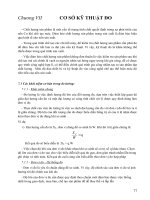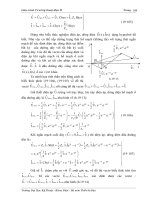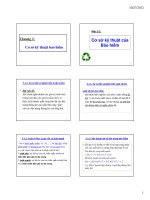An introduction to petroleum engineering (cơ sở kỹ THUẬT dầu KHÍ SLIDE TIẾNG ANH)
Bạn đang xem bản rút gọn của tài liệu. Xem và tải ngay bản đầy đủ của tài liệu tại đây (3.77 MB, 44 trang )
Course
Introduction to
Petroleum Engineering
Introduction to Petroleum Engineering
1
Chapter 1
An Introduction to
Petroleum Engineering
Introduction to Petroleum Engineering
2
Contents
Definitions and terminology
A brief history of petroleum industry
Vietnam’s petroleum industry
The role of petroleum industry
The field life cycle
Introduction to Petroleum Engineering
3
Learning outcomes
Understand the basic definitions and terminology in petroleum
industry.
Know the history of petroleum industry.
List the historical events of Vietnam’s petroleum industry
Evaluate the important role of petroleum industry in modern
life.
Differentiate the phases of field life cycle and it’s
characterization.
Introduction to Petroleum Engineering
4
Definitions and terminology
hydrocarbon:
A naturally occurring organic
compound comprising hydrogen
and carbon. Hydrocarbons can be
as simple as methane [CH4], but
many
are
highly
complex
molecules, and can occur as gases,
liquids or solids. The molecules
can have the shape of chains,
branching chains, rings or other
structures. Petroleum is a
complex mixture of hydrocarbons.
The most common hydrocarbons
are natural gas, oil and coal.
Introduction to Petroleum Engineering
5
Definitions and terminology
crude oil:
Crude oil is an organic liquid substance often found below the
Earth’s surface. It is made up of thousands of molecules
composed of different hydrogen and carbon atoms. Such
compounds are called hydrocarbons.
These hydrocarbons also contain different proportions of
impurities like oxygen, sulphur, nitrogen and heavy metal atoms.
Introduction to Petroleum Engineering
6
Definitions and terminology
petroleum:
The word ‘petroleum’ is derived from the Latin petra (which
means rock) and oleum (which means oil). It is commonly used
to refer to crude oil, but it may also refer to other related
hydrocarbons.
Some hydrocarbons are gaseous, rather than liquid. Methane is
the most common example of these hydrocarbon gases. This is
the kind of natural gas that we most often use in our kitchens at
home.
Introduction to Petroleum Engineering
7
Definitions and terminology
Introduction to Petroleum Engineering
8
Definitions and terminology
stock tank barrel:
A measure of the volume of treated oil stored in stock tanks. A
stock tank barrel is commonly abbreviated as STB.
1 Barrel [US, Oil] = 158.987295 Liters
1 Barrel [Oil] = 42 Gallons [US, Oil]
Introduction to Petroleum Engineering
9
Definitions and terminology
Introduction to Petroleum Engineering
10
Definitions and terminology
API gravity:
A specific gravity scale developed by the American Petroleum
Institute (API) for measuring the relative density of various
petroleum liquids, expressed in degrees. API gravity is gradated
in degrees on a hydrometer instrument and was designed so that
most values would fall between 10° and 70° API gravity. The
arbitrary formula used to obtain this effect is:
API gravity = (141.5/SG at 60°F) - 131.5
where SG is the specific gravity of the fluid.
Introduction to Petroleum Engineering
11
Definitions and terminology
Crude oil can be classified as either light or heavy depending on
its API gravity (or density). Generally, the higher its API gravity,
the lower its density.
light oil:
Oil that is lighter in colour, has a thin consistency and flows
easily usually contains less metals and sulphur compounds.
heavy oil:
Oil that is high in metal and sulphur content is considered lowgrade oil. It generally has too much carbon, not enough
hydrogen and is more timeconsuming to produce and hard to
refine.
Introduction to Petroleum Engineering
12
Definitions and terminology
Introduction to Petroleum Engineering
13
Definitions and terminology
Crude oil can also be classified as either sour or sweet,
depending on the amount of sulphur it contains.
sour oil:
Oil with a high sulphur content (0.5% and above, by weight) is
considered sour.
sweet oil:
Sweet crude oil, on the other hand, has low amounts of these
sulphur compounds.
Introduction to Petroleum Engineering
14
Definitions and terminology
Reference crude oil:
Some common crude oil types are used as a reference or
benchmark to determine the value of other crude oils. Some of
these reference crude oils are:
Brent Blend
A blend of several crude oils from fields in the North Sea region,
located above Germany and the United Kingdom. The price of oil
produced in Africa, Europe and the Middle East tends to be based
on this oil.
Introduction to Petroleum Engineering
15
Definitions and terminology
Introduction to Petroleum Engineering
16
Definitions and terminology
Dubai-Oman:
Used as a benchmark for Middle East sour crude oil flowing to
the Asia-Pacific region.
Tapis Crude:
Oil produced in Malaysia that is used as a reference for light oil
from East Asia.
West Texas Intermediate (WTI):
A very high-quality, sweet, light oil produced in North America.
Introduction to Petroleum Engineering
17
A brief history of petroleum industry
Drake Well Museum
Introduction to Petroleum Engineering
18
A brief history of petroleum industry
Introduction to Petroleum Engineering
19
Vietnam’s petroleum industry
President Ho Chi Minh visit to petroleum industrial park in Bacu – Azecbaijan (July, 23th, 1959)
Introduction to Petroleum Engineering
20
Vietnam’s petroleum industry
Signing ceremony of Vietnam - Soviet Union cooperation agreements on petroleum exploration
and production in Vietnam southern continental shelf in Kremlin, Moskva (July, 3rd, 1980)
Introduction to Petroleum Engineering
21
Vietnam’s petroleum industry
Introduction to Petroleum Engineering
22
Vietnam’s petroleum industry
Main oil fields in Vietnam
Introduction to Petroleum Engineering
23
Vietnam’s petroleum industry
The White Tiger oilfield is a major oil field in the Cuu Long basin
of the East Sea located offshore due east of the Mekong Delta of
Vietnam. The field contains major reserves hosted within highly
fractured granitic basement rocks.
Introduction to Petroleum Engineering
24
The role of petroleum industry
Crude oil is a central part of modern life and the world’s most
important energy resource. We rely on it in many ways for the
food we eat, the clothes we wear and the electronics we use at
home and in the workplace. Without oil, we would not be able to
continue to enjoy the same standard of living.
Introduction to Petroleum Engineering
25









